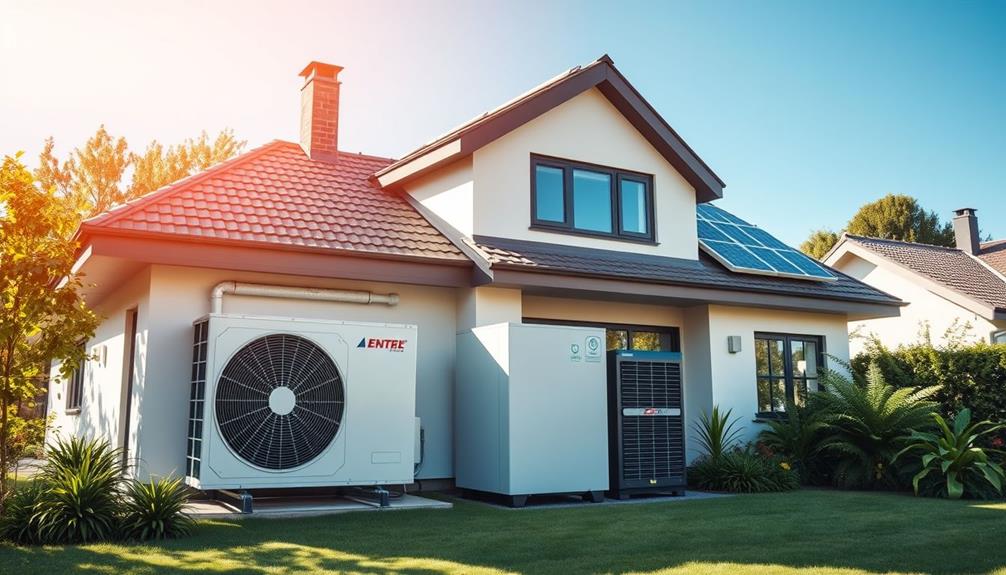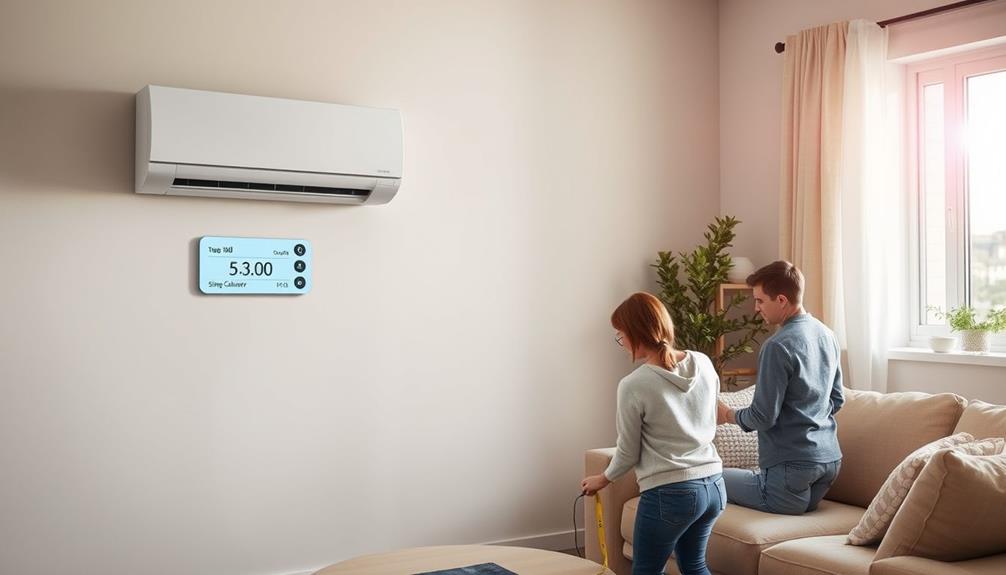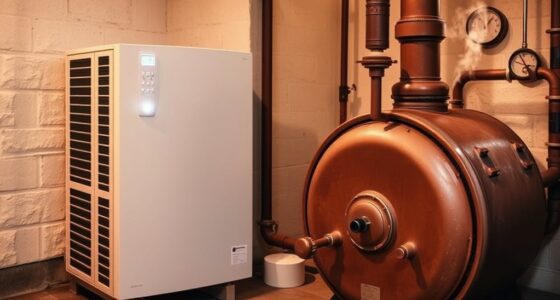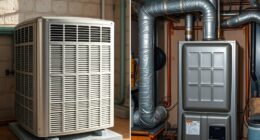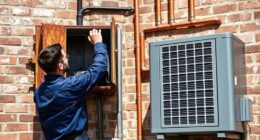Combining heat pumps with energy storage systems boosts your energy efficiency and sustainability like never before. This integration can help you achieve up to 83% self-sufficiency, greatly reducing your grid reliance. By utilizing advanced control strategies and dynamic simulations, you can manage heat demand while optimizing electricity supply, cutting your winter electricity demand by up to 41%. Liquid sorption storage, dual-staging approaches, and seasonal thermal energy storage play essential roles in this synergy, ultimately lowering your costs and carbon emissions. Want to discover the latest techniques and trends that can maximize your system's performance?
Key Takeaways
- Integrating energy storage with heat pumps can achieve up to 83% energy self-sufficiency, significantly reducing reliance on grid electricity.
- Seasonal thermal energy storage effectively lowers peak electricity demand, resulting in reduced energy costs and improved system efficiency.
- Dynamic building simulations optimize heat pump and energy storage performance, reducing winter electricity demand by up to 41%.
- Advanced control strategies in hybrid systems enhance energy efficiency, leading to a potential 20% decrease in electricity consumption.
- Utilizing liquid sorption storage with heat pumps can improve seasonal coefficient of performance (COP) by up to 26.1% in varying ambient temperatures.
Understanding Heat Pumps
Heat pumps revolutionize how we heat and cool our spaces by transferring heat using a refrigeration cycle. These versatile devices can serve both heating and cooling applications in your home or business.
Among the various types, air-source heat pumps (ASHPs) stand out for their efficiency, offering significant electricity savings. By employing predictive control strategies, you can reduce electricity consumption by up to 20% compared to traditional heating systems. Regular maintenance is essential to ensuring ideal performance, as common causes of heat pump failures can include refrigerant leaks and electrical issues.
A vital metric to evaluate is the Seasonal Performance Factor (SPF), which indicates a heat pump's overall efficiency throughout the heating season. Higher SPF values mean better energy performance, making it important to choose an efficient system.
Additionally, integrating heat pumps with energy storage systems, like thermal energy storage, enhances their overall efficiency and can achieve up to 83% self-sufficiency in energy supply for buildings.
Ideal operation of heat pumps can be affected by ambient temperature. By employing novel operational strategies, you can see performance improvements of up to 26.1% during higher temperature conditions.
This adaptability not only promotes the use of renewable energy but also maximizes the effectiveness of your heating system.
Benefits of Energy Storage

Energy storage systems offer considerable advantages when paired with heat pumps, enhancing energy efficiency and promoting sustainability. By integrating energy storage with your heat pump system, you can reduce winter electricity demand by up to 41%, making your building more energy-efficient.
This combination allows you to achieve an impressive autarky level of up to 83%, minimizing your reliance on grid electricity and boosting your energy independence. Additionally, utilizing approaches similar to geothermal energy generation can provide consistent energy supply, which can be particularly beneficial in optimizing your heat pump's performance.
Utilizing seasonal thermal energy storage effectively manages your energy supply and building demand, greatly lowering peak electricity demand during the colder months. This not only helps you save on energy costs but also contributes to a cleaner environment.
In fact, integrating energy storage with heat pumps can lead to a remarkable 52.5% reduction in carbon emissions compared to traditional electric heating systems.
Moreover, employing predictive control strategies within your energy storage system can decrease electricity consumption by up to 20%. This optimization enhances the overall performance and high efficiency of your heat pump operations, ensuring you get the most out of your investment while supporting a sustainable future.
Embracing energy storage with heat pumps is a smart choice for both your wallet and the planet.
Integration Techniques
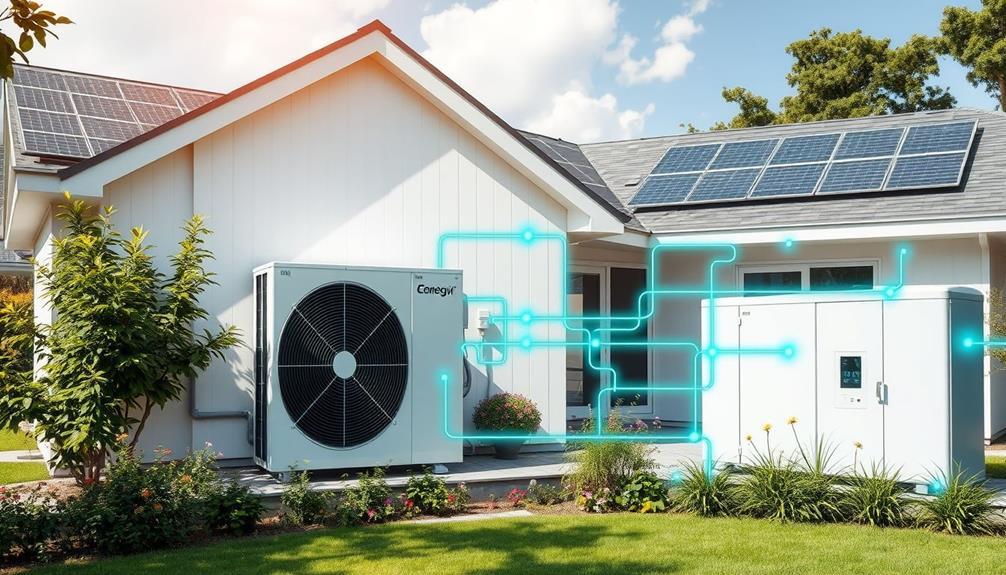
Often, successful integration techniques can greatly enhance the efficiency of heat pumps when paired with energy storage systems. By integrating liquid sorption storage with air-source heat pumps, you can achieve up to 83% autarky in building energy use, considerably reducing reliance on external electricity sources.
Utilizing dynamic building simulations allows you to optimize the sizing and performance of these energy storage systems, resulting in a potential 41% reduction in winter electricity demand. Additionally, incorporating pool maintenance equipment can contribute to a more efficient overall energy management strategy when considering heating needs.
One effective method is the dual-staging approach, which combines sorption storage with heat pumps. This technique effectively manages heat demand and electricity supply, boosting overall system efficiency.
Additionally, compact seasonal thermal energy storage can help support grid compliance by flattening peak electricity demand during winter months.
Incorporating advanced controller systems in hybrid setups enables seamless operation between heat pumps and backup technologies. This integration maximizes energy efficiency and minimizes operational costs, making it a win-win for both your budget and the environment.
Case Studies and Applications
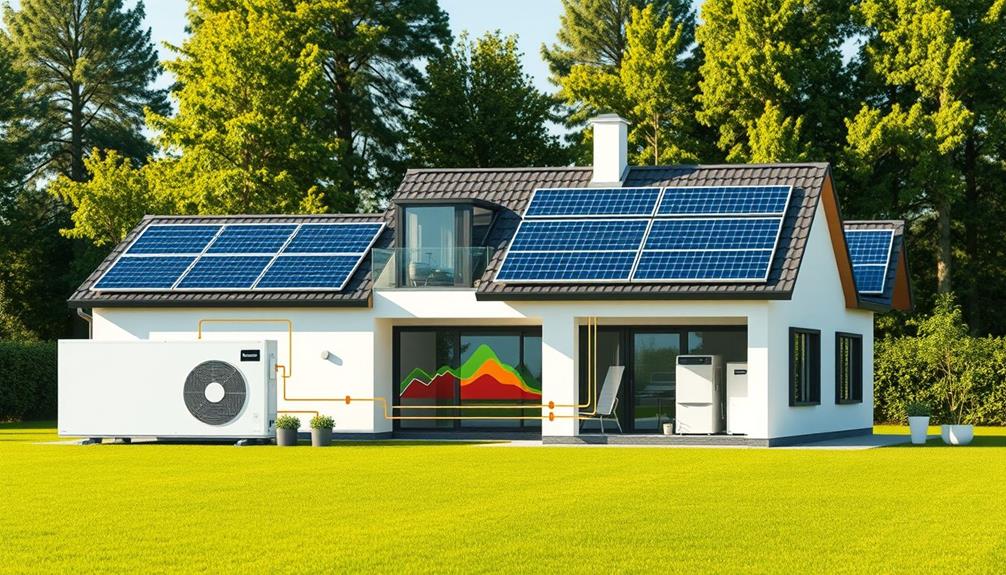
Numerous case studies illustrate the transformative impact of integrating heat pumps with energy storage systems in various applications. For instance, one study highlights that using liquid sorption storage with air-source heat pumps can achieve up to 83% self-sufficiency in energy use for buildings during winter months.
In Hong Kong, a combined sensible-latent heat storage system improved the seasonal coefficient of performance (COP) of heat pumps by 26.1%, thanks to optimized operation strategies. Additionally, effective management of energy consumption can lead to considerable reductions in emissions, aligning with the need for sustainable practices in energy use, as seen in gout management insights that emphasize dietary adjustments.
In a retrofitting case, installing a heat pump alongside battery storage resulted in a one-third reduction in electricity consumption, completely eliminating the need for gas boilers and greatly lowering carbon emissions.
Furthermore, research indicates that hybrid systems combining heat pumps with backup technologies can effectively manage extreme weather conditions and high electricity prices while maintaining reliable operation.
Dynamic building simulations further demonstrate that effectively coupling heat demand with electricity supply can reduce winter electricity demand peaks by up to 41%.
These examples show how integrating heat pumps and energy storage systems not only enhances efficiency but also contributes to sustainability and cost-effectiveness in various settings.
Future Trends in Efficiency
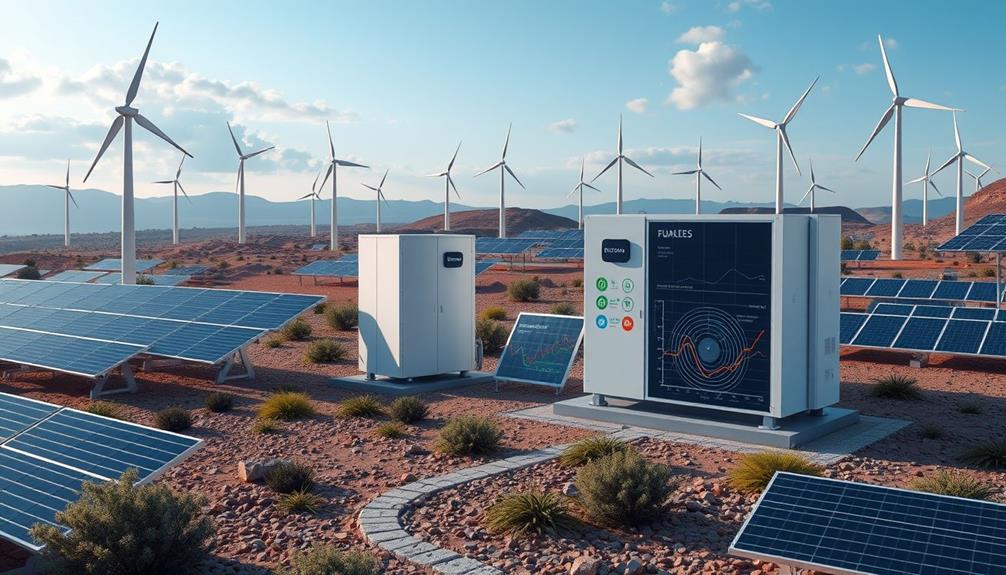
Emerging trends in efficiency for heat pumps and energy storage systems promise to reshape how we approach energy consumption in buildings. As you look towards the future, consider these key developments:
1. Liquid Sorption Storage Integration: This combination with air-source heat pumps can reduce winter electricity demand by up to 41%, leading to significant efficiency gains.
Additionally, tips on meal planning can be applied to energy management, promoting a balanced approach to both health and energy use.
2. Dynamic Building Simulations: Implementing double staging of sorption storage and electric heat pumps can achieve an impressive autarky level of up to 83%, enhancing energy self-sufficiency.
3. Advanced Control Strategies: Predictive control in hybrid systems has resulted in a 20% decrease in electricity consumption, optimizing energy efficiency through smart management.
With these advancements, you'll witness notable improvements in the seasonal coefficient of performance (COP) of heat pumps, particularly during high ambient temperatures, which have improved by 26.1%.
Additionally, incorporating phase change materials (PCM) can reduce tank volume by 44.9%, boosting overall system performance.
These trends not only enhance energy efficiency but also contribute to sustainable building practices, ensuring a smarter, more energy-efficient future.
Frequently Asked Questions
How Can I Maximize My Heat Pump Efficiency?
To maximize your heat pump efficiency, regularly maintain your system, optimize the operation settings based on real-time demand, and consider using smart controls. Also, guarantee proper insulation in your home to reduce energy loss.
Can You Have a Heat Pump and Solar Panels Together?
You can totally have a heat pump and solar panels together. This combo boosts efficiency, reduces energy bills, and cuts CO2 emissions, making your home eco-friendly while keeping you cozy. It's a win-win!
How Do Heat Pumps Compare to Other Types of Systems in Terms of Efficiency?
When you compare heat pumps to traditional systems, you'll find they're considerably more efficient. With a Seasonal Performance Factor of 3 to 4, they deliver three to four times more heat per electricity unit consumed.
How Can Heat Pumps Be Over 100% Efficient?
Heat pumps can be over 100% efficient because they transfer more thermal energy than the electrical energy they consume. This remarkable efficiency results from their ability to harness ambient heat, achieving coefficients of performance above three.
Conclusion
Incorporating heat pumps with energy storage systems creates a powerful synergy, much like a dance where each partner enhances the other's movements. By optimizing efficiency, you not only reduce energy costs but also contribute to a sustainable future. As technology evolves, staying ahead of the curve will guarantee you harness this dynamic duo effectively. Embrace these innovations, and you'll not just be keeping up with the times—you'll be paving the way for tomorrow's energy solutions.
